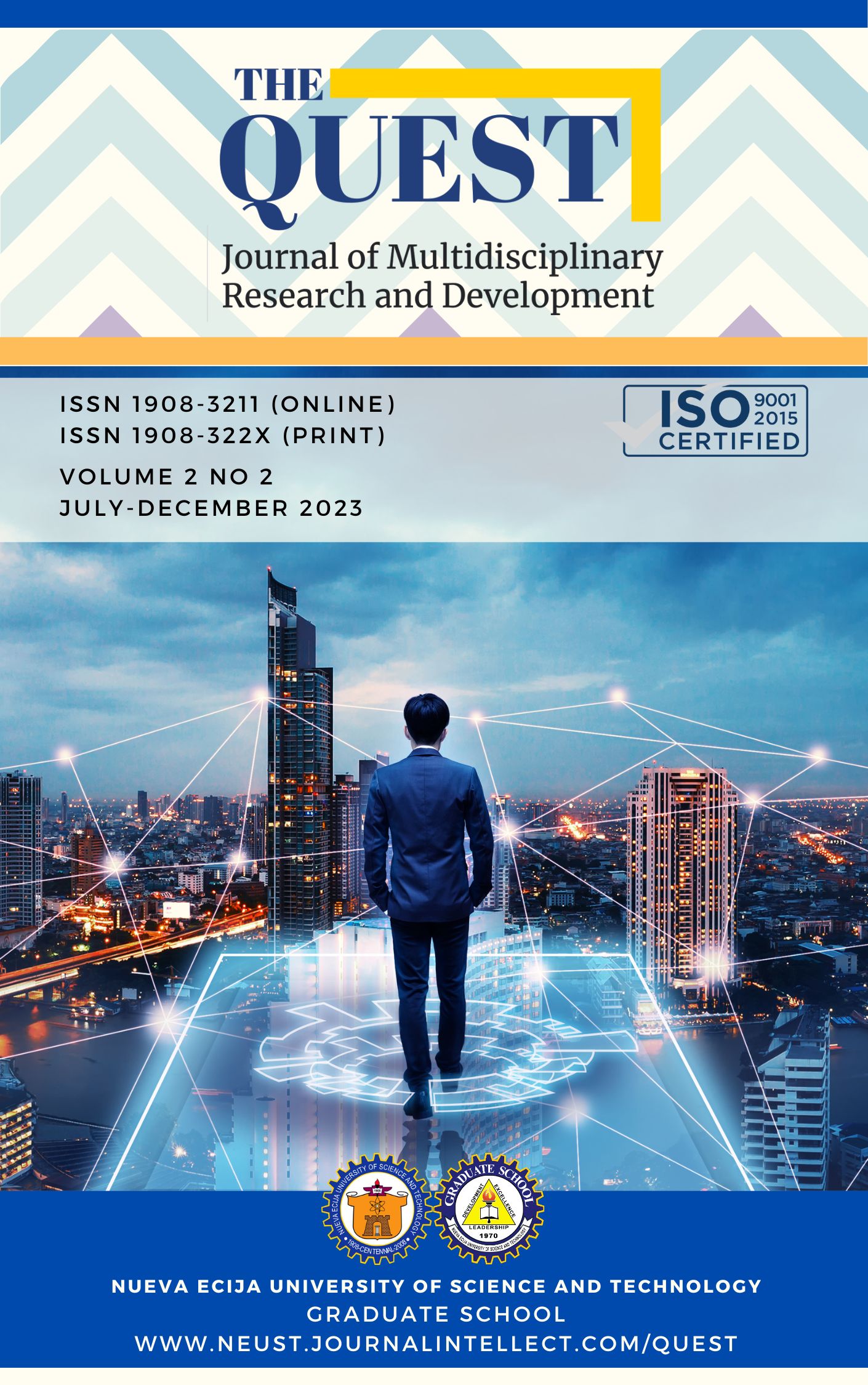Students’ Electronic Gadget Excessive Exposure and Family Interaction: A Basis for A Proposed Technology Detoxification Program

Published 12/30/2023
Keywords
- Education
How to Cite
Copyright (c) 2023 The QUEST: Journal of Multidisciplinary Research and Development

This work is licensed under a Creative Commons Attribution-NonCommercial 4.0 International License.
Abstract
The number of coronavirus disease (COVID-19) cases surged to more than 22 million across the globe. Schools responded by issuing several protocols. It called for the use of distance-learning programmes, open educational applications and platforms that schools and teachers can use to reach students remotely and limit the interruption of education. This research utilized the descriptive correlational type of research as a method among selected collegiate students of Nueva Ecija University of Science and Technology, Cabanatuan city, Nueva Ecija. Based on the foregoing findings the following conclusions are drawn: (1) The respondents remarked seldom in their electronic gadget excessive exposure; (2) The respondents remarked seldom in their family interaction assessment; (3) Majority of respondents have the general weighted average (GWA) range of 2.00 – 2.24 (good); (4) There is a high significant relationship between the students’ electronic gadget excessive exposure and their family interaction assessment by constantly communicating with their relatives from afar; (5) There is no significant relationship between students’ electronic gadget excessive exposure and their general weighted average during the first semester S.Y. 2020-2021; (6) There is no significant relationship between students’ family interaction assessment and their general weighted average during the first semester S.Y. 2020-2021; (7) There is a significant difference on the students’ electronic gadget excessive exposure and their family interaction assessment according to their home location, where students from rural areas experience “lagging” in their internet network connection and bond and interact more with their families, especially during the lockdown periods; and, (8) A proposed technology detoxification program was developed and organized for the collegiate students and their families that has the goal in detoxifying them in excessive technology usage.
References
- Atack, L., & Rankin, J. (2002). A descriptive study of registered nurses’ experiences with web-based learning. Journal of Advanced Nursing 40 (4), 457– 465.
- Bai, S., Reynoldsm B.M., Robles, T.F., & Repetti, R.L. (2017). Daily links between school problems and youth perceptions of interactions with parents: A diary study of school-to-home spillover. Social Development; 26: 813–830. pmid:29307958.
- Cuellar, N. (2002). Tips to increase success for teaching online: communication. CIN Plus 5 (1), 3– 6. Curtis, E. A., Comiskey, C., & Dempsey, O. (2016). Importance and use of correlational research. Nurse researcher, 23(6).
- Dawyer, F. (2003). Assessing Strategies for Developing Effective and Efficient Text for Distance Education: Traditional and Electronic, International Journal of Instructional Media, 30(1), 11-23.
- Epkins, C.C., & Harper, S.L. (2016). Mothers’ and fathers’ parental warmth, hostility/rejection/neglect, and behavioral control: Specific and unique relations with parents’ depression versus anxiety symptoms. Parenting; 16: 125–145.
- Fisher (1994). Mobile phone and school performance, adolescent medicine, 4(2): pp 607-622.
- Gani, S. A. (2016). Parenting Digital Natives: Cognitive, Emotional, and Social Developmental Challenges. Internasional Conference on Education, 870–880.
- Hara, N., & Kling, R. (2000). Student distress in a web-based distance education course. Information, Communication & Society, 3(4), 557-579.
- Johnson (2007). Television vision syndrome a global epidemic problem. Health Action,21(3): pp 25-30
- Kenny, A. (2002). Online learning: Enhancing nurse education. Journal of Advanced Nursing, 38 (2), 127–135.
- Kozlowski, D. (2002). Using online learning in a traditional face to- face environment. Computer in Nursing, 20 (1), 23–30.
- Leonard, J., & Guha, S. (2002). Education at the Crossroads: Online Teaching and Students' Perspectives on Distance Learning. Journal of Research on Technology in Education, 34 (1), 51-57.
- Moisey, S., Neu, C., & Cleveland-Innes, M. (2008). Community building and computer- mediated conferencing. Journal of Distance Education, 22(2), 15–42.
- NSO [National Statistical Office] (2019). Sample survey on Household Consumption on Education in India. Retrieved on 10 May, 2020 from: http://www.mospi.gov.in/sites/default/files/publica tion_reports/KI_Education_75th_Final.pdf.
- Omair, A. (2015). Selecting the appropriate study design for your research: Descriptive study designs. J Health Spec, 3: 153-6.
- Petrides, L.A. (2002). Web-based technologies for distributed (or distance) learning: Creating learner-centered educational experiences in the higher education classroom. International Journal of Instructional Media, 29(1), 69-77.
- Ramsey, M.A., & Gentzler, A.L. (2015). An upward spiral: Bidirectional associations between positive affect and positive aspects of close relationships across the life span. Developmental Review. Academic Press; pp. 58–104.
- Schoonenboom, J. (2012). The use of technology as one of the possible means of performing instructor tasks: Putting technology acceptance in context. Computers & Education, 59(4), 1309–1316.
- Thurmond, V. A., Wambach, K., Connors, H. R., & Frey, B. B. (2002). Evaluation of student satisfaction: Determining the impact of a beb-Based environment by controlling for student characteristics. The American Journal of Distance Education, 16(3), 169- 189.
- Vonderwell, S. (2003). An examination of asynchronous communication experiences and perspectives of students in an online course: A case study. Internet and Higher Education, 6(1), 77-90.
- Walker (1989). Caught in net, New York;23(5): 31-48.
- Zembylas, M., Theodorou, M., & Pavlakis, A. (2008). The role of emotions in the experience of online learning: Challenges and opportunities. Educational Media International, 45(2), 107- 117
